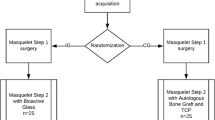Abstract
Background
Filling bone defect after debridement of infected nonunion is an orthopedic challenge. Since the volume of autologous bone graft available is limited, allograft, demineralized bone matrix, and calcium phosphate ceramic-based bone graft substitutes have come up as potential autograft expanders. This study was conducted to analyze the use of beta tri-calcium phosphate (B-TCP)-based composite ceramic as autologous bone-graft expander in the management of postinfective segmental gap nonunion of long bones managed with two-stage Masquelet’s technique.
Materials and Methods
42 consecutive patients with postinfective segmental long bone defects of 4–12 cm managed with Masquelet’s-induced membrane technique, operated between February 2012 and June 2015, were included in this prospective case series. During the second stage bone-grafting procedure, iliac crest autograft alone or mixed with B-TCP granules (ratio not exceeding >1:1) was used along with appropriate internal-fixation. Bony union (defined clinicoradiologically as ability to painlessly bear weight on affected limb without support along with bridging of 3 cortices on X-rays) was evaluated.
Results
Union was achieved in 80.9% patients (34/42) with index bone grafting. 100% union rate was achieved in patients where only autograft was used (15/15) and in nonsmoker femoral nonunion patients with the use of B-TCP (13/13). The use of B-TCP was associated with higher rate of nonunion in smokers (6/8, 75%) and in tibial nonunions (4/9, 55.5%). All, but one, of 8 patients with nonunion, united after the second-bone grafting procedure.
Conclusion
B-TCP is an efficacious and safe autologous bone graft expander in Masquelet’s two-stage management of post infective segmental gap nonunion of long bones. Patients should be counseled regarding increased risk of nonunion and need for repeat grafting with its use, especially if they are smokers or site of involvement is tibia.
Similar content being viewed by others
References
Karger C, Kishi T, Schneider L, Fitoussi F, Masquelet AC, French Society of Orthopaedic Surgery and Traumatology (SoFCOT). et al. Treatment of posttraumatic bone defects by the induced membrane technique. Orthop Traumatol Surg Res 2012;98:97–102.
Masquelet AC, Begue T. The concept of induced membrane for reconstruction of long bone defects. Orthop Clin North Am 2010;41:27–37.
Betz RR. Limitations of autograft and allograft: New synthetic solutions. Orthopedics 2002;25:s561–70.
Stafford PR, Norris BL. Reamer-irrigator-aspirator bone graft and bi masquelet technique for segmental bone defect nonunions: A review of 25 cases. Injury 2010;41 Suppl 2:S72–7.
Van Heest A, Swiontkowski M. Bone-graft substitutes. Lancet 1999;353 Suppl 1:SI28–9.
Muschik M, Ludwig R, Halbhübner S, Bursche K, Stoll T. Beta-tricalcium phosphate as a bone substitute for dorsal spinal fusion in adolescent idiopathic scoliosis: Preliminary results of a prospective clinical study. Eur Spine J 2001;10 Suppl 2:S178–84.
Epstein NE. A preliminary study of the efficacy of beta tricalcium phosphate as a bone expander for instrumented posterolateral lumbar fusions. J Spinal Disord Tech 2006;19:424–9.
van Haaren EH, Smit TH, Phipps K, Wuisman PI, Blunn G, Heyligers IC, et al. Tricalcium-phosphate and hydroxyapatite bone-graft extender for use in impaction grafting revision surgery. An in vitro study on human femora. J Bone Joint Surg Br 2005;87:267–71.
Saikia KC, Bhattacharya TD, Bhuyan SK, Talukdar DJ, Saikia SP, Jitesh P, et al. Calcium phosphate ceramics as bone graft substitutes in filling bone tumor defects. Indian J Orthop 2008;42:169–72.
Ogose A, Hotta T, Kawashima H, Kondo N, Gu W, Kamura T, et al. Comparison of hydroxyapatite and beta tricalcium phosphate as bone substitutes after excision of bone tumors. J Biomed Mater Res B Appl Biomater 2005;72:94–101.
Uchida A, Araki N, Shinto Y, Yoshikawa H, Kurisaki E, Ono K, et al. The use of calcium hydroxyapatite ceramic in bone tumour surgery. J Bone Joint Surg Br 1990;72:298–302.
Yamamoto T, Onga T, Marui T, Mizuno K. Use of hydroxyapatite to fill cavities after excision of benign bone tumours. Clinical results. J Bone Joint Surg Br 2000;82:1117–20.
Grundel RE, Chapman MW, Yee T, Moore DC. Autogeneic bone marrow and porous biphasic calcium phosphate ceramic for segmental bone defects in the canine ulna. Clin Orthop Relat Res 1991;266:244–58.
Calori GM, Phillips M, Jeetle S, Tagliabue L, Giannoudis PV. Classification of nonunion: Need for a new scoring system? Injury 2008;39 Suppl 2:S59–63.
Calori GM, Colombo M, Mazza EL, Mazzola S, Malagoli E, Marelli N, et al. Validation of the nonunion scoring system in 300 long bone nonunions. Injury 2014;45 Suppl 6:S93–7.
Carragee EJ, Comer GC, Smith MW. Local bone graft harvesting and volumes in posterolateral lumbar fusion: A technical report. Spine J 2011;11:540–4.
Ma L, Zheng LW, Sham MH, Cheung LK. Uncoupled angiogenesis and osteogenesis in nicotine-compromised bone healing. J Bone Miner Res 2010;25:1305–13.
Author information
Authors and Affiliations
Corresponding author
Rights and permissions
About this article
Cite this article
Gupta, S., Malhotra, A., Jindal, R. et al. Role of Beta Tri-calcium Phosphate-based Composite Ceramic as Bone-Graft Expander in Masquelet’s-Induced Membrane Technique. JOIO 53, 63–69 (2019). https://doi.org/10.4103/ortho.IJOrtho_240_17
Published:
Issue Date:
DOI: https://doi.org/10.4103/ortho.IJOrtho_240_17




